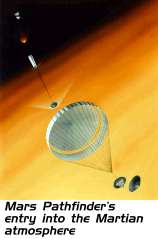
Current Issues:
SpaceViews
SpaceViews Update
Breaking News
Back Issues
Search
Subscriptions
Submissions
Forum
Space Sites of the Week
Home
Pathfinder's Bounce:
The Landing of Mars Pathfinder
It will not land daintily on a set of landing legs with a dignified burst of retrorockets. It will land most undignified, swathed within a bundle of airbags that will protect it as it comes to a stop after bounding across the Martian terrain. But when you're trying to squeeze a Mars landing mission into the budget of a Discovery-class mission, you'll do what it takes to safely put your craft down on the Red Planet.
Unlike the Viking landers in 1976, or the Surveyor landers on the Moon in the 1970s, Mars Pathfinder will use a landing procedure that eschews landing legs -- and the costs and complications that come with them -- with a simpler but untried system that, even if it works, may not be used again in future missions.
 The landing sequence beings about thirty minutes before Martian landfall. At that time the cruise stage of the spacecraft, which has protected and cooled Mars Pathfinder since launch, is jettisoned. An hour before the cooling fluid in the cruise stage was vented. The spacecraft and aeroshell now make their final approach to the planet.
The landing sequence beings about thirty minutes before Martian landfall. At that time the cruise stage of the spacecraft, which has protected and cooled Mars Pathfinder since launch, is jettisoned. An hour before the cooling fluid in the cruise stage was vented. The spacecraft and aeroshell now make their final approach to the planet.
About five minutes before landing, the spacecraft encounters the Martian atmosphere at a speed of 26,500 kmph (16,400 mph). The heatshield dissipates the heat of entry into the tenuous Martian atmosphere as the spacecraft suddenly slows from nearly 7.5 km/s to only 0.4 km/s (900 mph). Deceleration reaches a peak of 20 g's, 20 times the force of Earth's gravity, during this time. Accelerometers on the spacecraft use this deceleration as a prompt to start the landing procedure.
About 2 to 3 minutes after atmospheric entry, a parachute deploys. The 7.3-meter (24-foot) parachute, a modified version of the ones used in the Viking landings, will slow Pathfinder down to only 65 meters/second (145 mph).
 Twenty seconds after the parachute deploys, the heatshield is removed. The spacecraft itself starts to rappel down a cable attached to the back part of the aeroshell, to which the parachute is attached. This is designed to give the spacecraft room to inflate its airbags.
Twenty seconds after the parachute deploys, the heatshield is removed. The spacecraft itself starts to rappel down a cable attached to the back part of the aeroshell, to which the parachute is attached. This is designed to give the spacecraft room to inflate its airbags.
Eight seconds before landing, when the spacecraft is about 300 meters (1,000 feet) above the surface, the airbags will inflate. The airbags are inflated in less than a third of a second to a pressure of 1 psi, only about 7 percent of normal atmospheric pressure on Earth but much higher than the pressure of the Martian atmosphere.
When the spacecraft is just 100 meters (330 feet) above the surface (a radar altimeter on the spacecraft provides altitude information for this stage of the landing), a set of solid rocket motors above the spacecraft, on the back section of the aeroshell, fire. This effectively slows the spacecraft to a stop while still 10-20 meters (30-60 feet) above the surface.
 Then the airbags are put to use. A charge cuts the tether connecting the spacecraft to the parachute and aeroshell. The parachute and aeroshell fall away from the spacecraft, which, encased in airbags, drops to the surface. Pathfinder may hit the surface as fast as 25 meters/second (55 mph). The landing will take place at 1:07pm EDT July 4.
Then the airbags are put to use. A charge cuts the tether connecting the spacecraft to the parachute and aeroshell. The parachute and aeroshell fall away from the spacecraft, which, encased in airbags, drops to the surface. Pathfinder may hit the surface as fast as 25 meters/second (55 mph). The landing will take place at 1:07pm EDT July 4.
Friction and gravity will bring Pathfinder to a stop, but not after the spacecraft bounces across the Martian terrain, going perhaps as high as 12 meters (40 feet) and making jumps of up to 200 meters (660 feet) between bounced. The bounce phase will take up to a few minutes to complete.
Once the spacecraft comes to a stop, a charge will blow that will unlock the three pain pedals that form the base of Mars Pathfinder, allowing them to open. As that happens, a set of internal lines in each of the airbags will start up, retracting the airbags. This process also deflates the bags as gas is vented out through special ports in the airbags. Mission planners have allowed three hours for this to happen.
 Throughout this time, the spacecraft is not in communication with the Earth. During the landing phase on a simple carrier wave is transmitted. Engineers on Earth will use the Doppler shift of the frequency to determine the speed of the spacecraft, and hence where in the landing phase it is at.
Throughout this time, the spacecraft is not in communication with the Earth. During the landing phase on a simple carrier wave is transmitted. Engineers on Earth will use the Doppler shift of the frequency to determine the speed of the spacecraft, and hence where in the landing phase it is at.
If all goes well, and the spacecraft is on the ground and functioning well, the first images of the surface of Mars will be transmitted back at around 7-8pm EDT. If the situation looks good, mission controllers will tell Pathfinder to deploy the ramp for the rover. Sojourner could be moving across the Martian surface as early as midnight EDT.
If there are problems with the landing, however, that keep Pathfinder from using its high-gain antenna, mission planners till tell the spacecraft to send back a series of highly-compressed black-and-white images using the low-gain antenna. Teams on Earth will use the images to diagnose the problem and determine the best solution.
For more information on the entry, descent, and landing procedures for Mars Pathfinder, check out the Mars Pathfinder Web site, at http://mpfwww.jpl.nasa.gov/mpf/edl/edl1.html.
